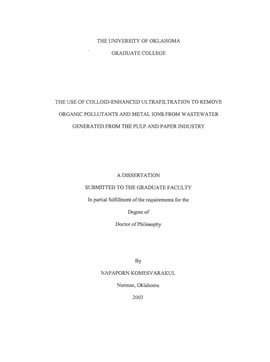| dc.contributor.advisor | Scamehorn, John F., | en_US |
| dc.contributor.author | Komesvarakul, Napaporn. | en_US |
| dc.date.accessioned | 2013-08-16T12:18:59Z | |
| dc.date.available | 2013-08-16T12:18:59Z | |
| dc.date.issued | 2003 | en_US |
| dc.identifier.uri | https://hdl.handle.net/11244/612 | |
| dc.description.abstract | Colloid-enhanced ultrafiltration (CEUF) is a surfactant based separation technique which requires low energy and produces high rejection with reasonable flux rates. In micellar-enhanced ultrafiltration (MEUF), surfactant at a concentration well above critical micelle concentration (CMC) is introduced into a given contaminated solutions. At a sufficiently high concentration, most of surfactant will be in micellar form. Polyelectrolyte micellar-enhanced ultrafiltration (PE-MEUF) is a modified MEUF technique in which a mixture of a surfactant and an oppositely charged polymer mixture is used as a colloid. The colloid can have a net negative charge if an excess amount of the polymer is used. Pollutants can associate with colloids: surfactant micelles or surfactant-polymer aggregates solubilize organic solutes and metal ion binds to the negatively charged surfactant-polymer aggregates. The studies herein investigate the application of MEUF and PE-MEUF for the removal of ionizable organic solutes (chlorophenols) and metal ions. Higher organic solute removal is observed in MEUF than in PE-MEUF for all systems studied. However, surfactant leakage is significantly reduced in PE-MEUF, as compared to MEUF. For chlorophenols with a higher degree of chlorination (low water solubility), high rejections are reported in both MEUF and PE-MEUF. When the organic solute is deprotonated, the solubilization in the micelles is enhanced due to ion-ion interaction between the cationic surfactant head group and the phenolate anion. The effect of added salt on the solubilization and surfactant leakage is investigated in both MEUF and PE-MEUF. Added salt enhances the solubilization and reduces the surfactant leakage in MEUF, whereas it decreases the solubilization and increases the surfactant leakage in PE-MEUF. Surfactant-polymer aggregates are shown to be effective in the simultaneous removal of an organic solute and a metal ion. The effects of surfactant and polymer concentrations as well as surfactant to polymer concentration ratio are all important. Ultrafiltration experiments are used to determine the effect of salt on gel point (the point at which flux becomes zero) for PE-MEUF. | en_US |
| dc.format.extent | xxii, 236 leaves : | en_US |
| dc.subject | Colloids. | en_US |
| dc.subject | Surface active agents. | en_US |
| dc.subject | Engineering, Chemical. | en_US |
| dc.subject | Water reuse. | en_US |
| dc.subject | Engineering, Environmental. | en_US |
| dc.subject | Ultrafiltration. | en_US |
| dc.title | The use of colloid-enhanced ultrafiltration to remove organic pollutants and metal ions from wastewater generated from the pulp and paper industry. | en_US |
| dc.type | Thesis | en_US |
| dc.thesis.degree | Ph.D. | en_US |
| dc.thesis.degreeDiscipline | School of Chemical, Biological and Materials Engineering | en_US |
| dc.note | Major Professor: John F. Scamehorn. | en_US |
| dc.note | Source: Dissertation Abstracts International, Volume: 64-06, Section: B, page: 2788. | en_US |
| ou.identifier | (UMI)AAI3093580 | en_US |
| ou.group | College of Engineering::School of Chemical, Biological and Materials Engineering | |
